| Tactics
and Strategy
by David Dellenbaugh
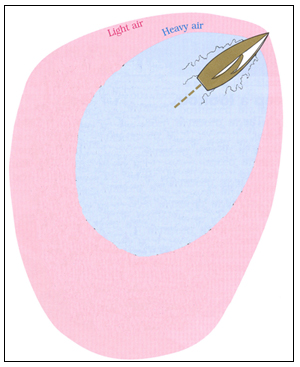 Upwind
Tactics Upwind
Tactics
Cross
other boats when you can.
When the wind direction is oscillating, it usually
pays to tack on the headers. But if changes in
the wind are subtle or gradual, it may be easier
to recognize shifts by watching the relative positions
and headings of other boats. For example, a header
will make you look better relative to boats on
your windward ‘hip.’ If suddenly it
looks like you have gained the ability to cross
boats on your hip, it’s probably a good
time to tack and consolidate your gain. The corollary
is that you don’t want to let other boats
cross you. When they are sailing on a lift, tack
to leeward and ahead so you beat them to the next
shift.
Tack when headed to the
median.
When the wind is shifty, your basic strategy is
to tack on the headers. But exactly when is the
best time to tack? The biggest mistake for most
sailors is sailing too far into the header. If
you keep going until you get the maximum shift,
you will sail roughly half the beat on headers
instead of lifts, which is not fast. To avoid
this, tack when you get knocked to your median
heading.
‘Spend’ your
lead.
In one-design racing, it doesn’t matter
how far you are ahead of another boat when you
cross the finish line. Therefore, don’t
take chances trying to maintain or build a large
margin. In fact, it’s often smart to “spend”
(i.e. use up) some of your lead in order to stay
in a conservative position and make sure you beat
the boat behind.
Avoid bad air.
Boats always cast wind shadows, but
these are more harmful in light air. When a stream
of slow-moving air is interrupted (e.g. by a boat’s
sail plan), it takes a long time for that stream
to return to normal. In light air, you may feel
another boat’s shadow as far as 10 lengths
away, and when you are in that shadow, you may
have only half as much wind as boats in clear
air. This is a problem because you were already
underpowered. In heavy air, the wind stream re-forms
much more quickly, so you might feel a shadow
only 5 boatlengths to leeward of another boat.
And that won’t hurt as much because you
still have a relatively strong breeze.
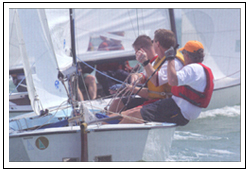 Wave
a port tacker across. Wave
a port tacker across.
When you have a good lane on starboard tack and
you want to keep going toward the left side, don’t
automatically yell “Starboard” to
every port tacker that tries to cross in front
of you. Having them tack on your lee bow is probably
not the best thing. It’s often much better
to let the other boat go across, even if this
means you will lose a little by bearing off behind
them. When you are still several lengths away,
yell “Go ahead,” or other words to
make it clear they can keep going. Just be sure
to communicate loudly and clearly.
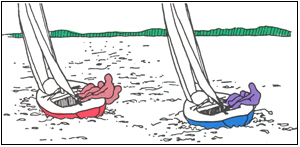 Use
a blocker to hold your lane. Use
a blocker to hold your lane.
A second way to protect your lane on starboard
tack is by using a “blocker.” A blocker
is another boat on starboard tack that’s
to leeward and ahead of you, in a position to
intercept incoming port tackers. Those boats will
either have to lee-bow the blocker or duck behind
the blocker (and go behind you too), leaving you
free to continue sailing in your lane.
Bear off at port tackers.
A third way to protect your clear-air lane on
starboard tack is to bear off slightly toward
a converging port tacker when you are roughly three
or outpatients away. The idea is to force her
to tack earlier (to avoid you) and then head up,
using your extra speed to gain separation to windward.
If you do this right, it will help you hold your
lane on starboard tack for at least a little while
longer.
Fleet
Strategy
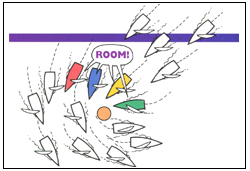 Avoid
needless risk. Avoid
needless risk.
When your ace sailboats, every choice you make
involves a certain risk. For example, if you try
to squeeze inside at a crowded jibe mark, you
are taking a relatively large chance. Before you
make any race decision, do two things:
1) consider you options and how much risk is involved
with each. In other words, what is the probability
of success for each course of action?
2) Decide how much risk you are willing to take. When
it’s early in a race or series, you probably
shouldn’t take too many chances. But as
you get near the finish, you may be willing to
be more risky to achieve your goals.
Are you happy?
 When
you make tactical and strategic plans during a
race, keep the answer to one important question
in mind: “Are you happy with your current
position in the race?” In other words, do
you need to pass boats ahead of you, or are you
content to hold your place? This is a critical
bit of information for making decisions about
how much risk to take. For example, if you need
to catch three boats on the last leg to win the
regatta, you might decide to take a flier. But
if you can win the series simply by holding your
position, you should be more conservative and
cover the boats behind you closely. When
you make tactical and strategic plans during a
race, keep the answer to one important question
in mind: “Are you happy with your current
position in the race?” In other words, do
you need to pass boats ahead of you, or are you
content to hold your place? This is a critical
bit of information for making decisions about
how much risk to take. For example, if you need
to catch three boats on the last leg to win the
regatta, you might decide to take a flier. But
if you can win the series simply by holding your
position, you should be more conservative and
cover the boats behind you closely.
Stay on the favored
side of other boats.
When your strategy says the right side of the
course is favored, it may not be enough simply
to sail toward that part of the beat or run. If
all the other boats go even farther right, you
are actually on their left, which is not good.
Since your only goal in the race is to beat your
competitors, you must use your strategy to position
yourself relative to them. If you like the right
side, for example, you should generally stay on
the right side of the boat (or boats) you want
to beat.
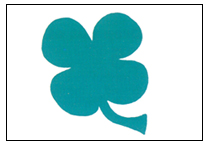 Create
good luck. Create
good luck.
Perhaps you think it’s crazy to
suggest that sailors may have some control over
their own luck. After all, isn’t luck random?
I used to think so until it became apparent that
the best sailors usually have most of the good
luck! Coincidence? I doubt it. I agree with the
person who said luck is ‘what happens when
preparation meets opportunity.’ If you are
well-prepared and work hard, you are more likely
to be lucky.
Know the score.
When your are trying to make a strategic game
plan and assess the amount of risk you’re
willing to take, you have to know where you stand
in the fleet. If you’re in 3rd place for
the regatta, for example, you will have a very
different approach than if you’re in 10th.
So write down the series scores and bring them
out with you. Of course, there are many races
where the overall scores don’t matter, such
as the first few races of a series. But after
that it may be important to know the standings.
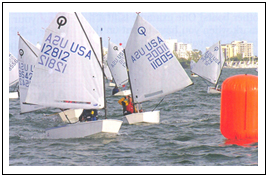 Beware
of the middle. Beware
of the middle.
On most beats, it’s good to avoid the edges
of the course, but when you have light air and
a large fleet there often seems to be less wind
in the middle of the course than on either side.
That’s probably because a large fleet acts
like as now fence, and the wind has a hard time
getting through all the sails. As a result, the
breeze tends to bend around and lift up over the
bulk of the fleet (which is in the middle). So
pick a side and go there; if you play the middle
you may get passed on both sides!
At the end of a run,
protect the left side.
At the beginning of a run, your choice about whether
to go left or right should be based primarily
on strategic factors like the wind pressure and
shifts. As you get closer to the leeward mark,
however, think tactically. If you are rounding
the mark to port, it’s smart to play the
left side of the course (looking downwind). This
will give you two advantages over the fleet -
you’ll be inside at the mark and also on
starboard tack when you converge with the other
boats.
Dave publishes the newsletter
Speed & Smarts. For a subscription call: 800-356-
2200 or go to: www.speedandsmarts.com
TOP
|